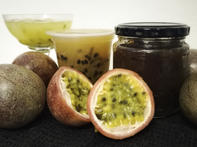Granadillas, also called passion fruit, have a tough purple or yellow skin and a seedy, aromatic flesh. It can be eaten fresh or processed to a pulp or concentrate.

The fruit is cut open and the gelatinous flesh is scooped out with a spoon. Eaten fresh, granadillas have a seedy pulp that yields a tangy aromatic juice that is high in vitamin C, fibre and carotenoids - yellow pigments and precursors to vitamin A. It is also a source of phosphorus, iron, calcium and vitamin B6, which helps regulate blood sugar and can also promote a healthy immune system.
In South Africa, granadillas are mostly processed into granadilla pulp with a small percentage sold as fresh fruit. Granadilla pulp is used in various ways: in the production of ice cream, to enhance the flavour of juice blends, as toppings for cheesecakes, in yoghurt, sweets and preserved as a jam. Valued-added granadilla products include pickle, lassi and curd.
Medicinal Value of Granadillas
Medicinally, granadillas are utilised by native Brazilian tribes as a heart tonic and in a drink to treat respiratory issues such as asthma, coughs and bronchitis.
In Peruvian traditional medicine, granadilla juice is used for urinary infections and in Madeira, the juice treats gastric cancer.
It is believed that granadillas can stimulate milk flow in breastfeeding women, and can be used medically as a sedative.
Granadilla rinds are high in pectin (a fibre), which a valuable ingredient in the medicinal industry. Pectin is used to make medicines to treat high cholesterol, prevent colon cancer and prostate cancer and is used for diabetes. In the food industry, pectin is used as a thickening agent. The rind is also used to treat headaches, asthma, diarrhoea and insomnia.
Tea brands with granadilla flowers treat respiratory conditions as mentioned above - coughs, asthma and whooping cough.
Granadilla root is diuretic, a narcotic, can induce vomiting and is used to expel parasites. It contains passiflorine, a substance that is isolated and used in medicines to treat sleeplessness.
Both the root and leaves can be powdered and mixed with oil to make a soothing poultice for skin infections.
Please note: Information is for educational and informational purposes only and may not be construed as medical advice. The information is not intended to replace medical advice or treatment offered by healthcare professionals.
By Marinda Louw